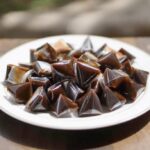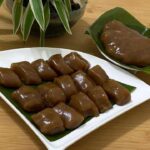Dodol: A Popular Coconut Toffee in Malaysia
Dodol, oh how sweet and chewy it is! This toffee-like sweet candy has captured the hearts of many Malaysians, as well as those in other parts of Southeast Asia and even the Indian subcontinent. Dodol is essentially prepared with a base of coconut milk, palm sugar, and rice flour. It is characterised by its dense, chewy texture, and is typically cut into square blocks, strips, or diamonds, making it easy to savour every delightful bite.
Now, the exact birthplace of Dodol remains shrouded in mystery, but the word “dodol” is said to have emerged from the Sundanese language of West Java, Indonesia. Throughout the Maritime Southeast Asia, Dodol has earned its reputation as one of the oldest indigenous sweets, with a legacy that spans generations.
Crafting Dodol is an art form in itself. The journey begins by slowly simmering a mixture made from coconut milk, rice flour, salt, and sugar. The secret lies in the stirring! Constantly stirring the Dodol mixture is crucial, for if left unattended over the heat for too long, disaster strikes – it will burn! And trust me, you wouldn’t want the texture and flavours of this heavenly treat to go up in smoke. As time goes on, the mixture thickens, reaching a delightful gum-like consistency. But here’s the catch, this whole process takes hours, making it quite a challenge for a single person to undertake.
Once the Dodol has reached its desired texture, it is carefully poured into a vessel to cool. In the olden days, banana leaves were the traditional choice for this purpose, but nowadays, heat-safe containers are commonly used in factories. Once the Dodol has cooled down, it’s time to get creative with the shapes. Back in the day, Dodol was lovingly wrapped in coconut shells, upih (made of tree bark), or skillfully woven mengkuang (pandanus leaves) and daun palas (from the Palas tree). However, the most authentic way to store Dodol is by hanging it in a coconut shell, which gracefully dangles from a kitchen beam. And here’s a delightful bonus – once you’ve devoured the Dodol, that coconut shell can be repurposed as a coffee cup too!
In today’s fast-paced world, Dodol stands tall as one of those rare traditional food treasures that has resisted the tide of modernity. The beauty lies in its traditional recipes that have been passed down through the generations. Several states in Malaysia, including Melaka, Perak, Negeri Sembilan, and Johor, are prominent producers of Dodol. Different states boast their own variations, such as dodol penganan, kelamai, dodol cair, wajik sirat, dodol kelapa, dodol pisang, dodol pulut hitam, dodol durian, dodol mango, dodol kopi, etc. Nowadays, the most popular variations of dodol in Malaysia are made from durian, coconut and banana.
As an authentic Malay delicacy, Dodol is available commercially all year round in Malaysia, but it truly takes centre stage during festive occasions such as Hari Raya Aidilfitri and Aidiladha. The next time you find yourself in Malaysia during these joyous celebrations, make sure to treat yourself to the blissful delight of Dodol. You won’t be disappointed, but here’s a gentle reminder though. Dodol is a treat to be savoured in moderation, as it bursts with rich flavours and packs quite a caloric punch. So, indulge wisely!




